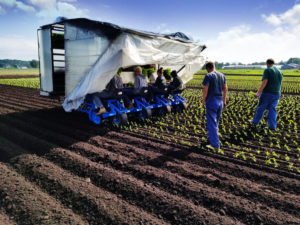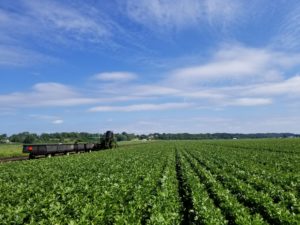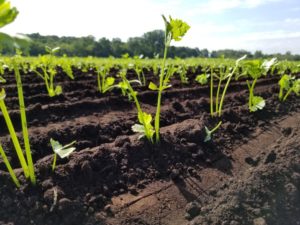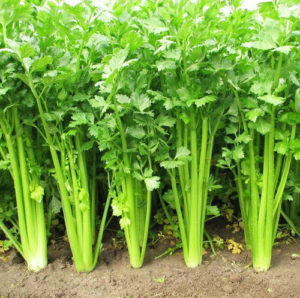IR-4 Project worked with Agriculture and Agri Food Canada to conduct studies on the herbicide pendimethalin to expand its label to include celery and other minor crops.
Celery is a minor crop grown primarily in California and Michigan for fresh market and processed product sales. According to the Ag Marketing Resource Center, in 2017 California harvested 23,500 acres of celery valued at nearly $302 million. During that same year, Michigan harvested 1,600 acres of celery worth $12.6 million.
Celery is not an easy crop to grow. It requires cooler temperatures and an adequate and consistent amount of water and has a longer growing season.
“Celery is a high risk crop and an expensive crop to grow,” said horticulture professor and weed scientist Bernard Zandstra at Michigan State University. “Michigan growers grow their celery crops in organic muck soils. California growers produce their celery in mineral soils. In Michigan, most of the celery is produced from transplants. California growers also produce most of their celery from transplants. Very few celery crops are started from direct seeding.”

Need for weed control
Weed control is one of the major issues facing celery growers in both Michigan and California.
“Every celery field situation has its own weeds and its own problems,” Zandstra said. “Muck soils tend to retain moisture so a lot of weeds germinate throughout the growing season. It’s a constant pressure. In California, growers irrigate their fields throughout the season. They may have a different weed spectrum, but like Michigan growers, they always have a lot of weed pressure.
“Even though Michigan celery growers are a small group, they are very good growers and very active. Both Michigan and California growers have been pushing to get the herbicide pendimethalin registered for use on celery. Pendimethalin on celery received a priority designation from IR-4.”
Michigan State researchers began field research with pendimethalin at least 10 years ago.
“We have done field testing for weed control efficacy and crop safety,” Zandstra said. “We found that pendimethalin is safe for use on celery. Most of the efficacy and crop safety studies in Michigan were conducted on grower fields.
“We have worked with several growers on the pendimethalin project. They might have slightly different soil types. It’s all muck, but there are some differences in the soil and the growers’ production practices.”
Cooperative herbicide trials
The residue studies conducted on pendimethalin were done jointly between IR-4 Project and the Canadian Pest Management Centre.

“The Pest Management Centre is the minor-use program of Agriculture and Agri Food Canada, which is like the Canadian USDA, aka IR-4 North,” said Dan Kunkel, national director at IR-4 Project headquarters, Rutgers University. “IR-4 does a number of studies cooperatively with Agriculture and Agri Food Canada. The Canadians managed the residue studies on pendimethalin and IR-4 scientists conducted some of the field trials. In other cases, IR-4 manages the studies that are done jointly and Canada will add field trials to IR-4 studies.
“When the pendimethalin studies were finished, the results were submitted in one report to our respective regulatory agencies at the same time. It’s a pretty seamless process. The report submitted to EPA and the Pest Management Regulatory Agency in Canada indicated that pendimethalin use on celery would not result in an adverse impact on man and the environment. The two agencies approved the new label.”
Kunkel, Zandstra and many others at IR-4 played a critical role in expanding the pendimethalin label to include use on celery.
“Bernie championed the need from the stakeholders more than anyone,” Kunkel said. “For celery we had requests from California and Oregon as well. Most of the requests came from university or extension farm advisors that requested the study on pendimethalin. For this particular use, we have product performance data that goes back 10-12 years and Bernie did a lot of those studies. Part of the reason for doing so many studies was to convince the registrant that there is not going to be a liability issue. The registrants like to see crop safety data before supporting new herbicides uses. Much of the data that Bernie generated helped demonstrate crop safety.”
Kunkel said another important factor that moved the project forward was Canada’s participation in the study and its priority to register pendimethalin on celery. Canadian researchers not only conducted the residue studies, but also analyzed the samples and prepared the final report.
Other minor crops covered

The label expansion for pendimethalin also included other minor crops.
“Cardoon, which is a very minor crop grown primarily in California, was covered by extrapolation of the studies done on celery,” Kunkel said. “IR-4 didn‘t have to generate any residue data for this crop.”
Bill Barney, who is a study director at IR-4, submitted the final pendimethalin report to EPA.
“This report also included rosemary and monarda,” Barney said. “These were not included in the celery residue study. But in this case there was an existing tolerance for pendimethalin on mint. We were able to use that tolerance to extrapolate to both rosemary and monarda to include them for minor-crop use for pendimethalin.”
Expanding herbicide options
Pendimethalin is a pre-emergent herbicide that will be an important addition to an integrated weed management program for celery growers.
“It is a very good herbicide for control of grasses,” Zandstra said. “It is somewhat limited in its control of broadleaf weeds. It controls common purslane, common lambsquarters and pigweeds, which are all serious weeds in celery fields. Those are the main weeds that celery growers would be targeting.”
Pendimethalin is in the herbicide class of dinitroanilines.
“There are a number of other herbicides that can be rotated or tank mixed with pendimethalin,” Kunkel said. “Being able to rotate these herbicides will help to prevent resistance. Some of the products are pre-emergent and their use patterns are very similar to pendimethalin. It should be a good mixing partner with some of the other herbicides already registered which can provide celery growers with broader weed control.

“Also with pendimethalin there is less of a problem with carry-over to the following crops that are being planted. This can be an issue with some herbicides which have a longer carry-over and have label restrictions.”
Zandstra said although herbicide resistance can be an issue, Michigan celery growers are very conscious of the herbicides they are applying to their crops.
“With vegetables we haven’t encountered a lot of herbicide resistance because the growers tend to rotate their crops regularly,” Zandstra said. “When they rotate crops, they rotate herbicides. They are aware of the problems and they try to stay ahead of them. There are a few times that we have seen resistance. Any time herbicides can be used with different modes of action that really helps to avoid resistance. For celery there are several pre-emergent herbicides with different modes of action. The growers keep this in mind when making their applications.
“We encourage growers to always use best management practices that often include some sort of tillage practice. Often celery growers have to apply nitrogen during the growing season and they can combine the pass of a fertilizer spreader with some type of cultivation equipment. Sometimes if growers have specific weeds in the fields they will send employees through to remove them. It’s getting harder to find enough people to do those kinds of manual tasks. Integrated weed management is an ideal that the growers are trying to achieve.”
For more: Bernard Zandstra, Michigan State University, Department of Horticulture, East Lansing, MI 48824; zandstra@msu.edu.
PR#10746 Celery (weeds)
David Kuack is freelance technical writer in Fort Worth, Texas; dkuack@gmail.com.
